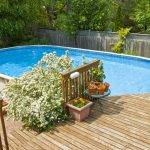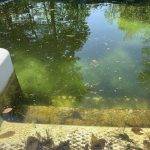Avoid these pool chemicals! In this article, we will touch on many pool products that our users have found to be ineffective, expensive, or just plain harmful to their pool water.
Metal Based Algaecides or Algae Control
Copper or silver is commonly used to control algae and is introduced into the water via algaecide products. Common brand names for metal-based controls include The Frog, Nature 2, or anything labeled as an “ionizer”. While metals can kill algae, they do not kill viruses. For this reason, free chlorine is still required to maintain a safe and sanitary pool. Besides the health issues, metal based products can stain pool surfaces and can cause swimmers’ hair to turn green (often incorrectly attributed to chlorine).
Ammonia
Products containing ammonia bind with chlorine to produce monochloramine, which can kill algae. The issue is that the ammonia will deplete your chlorine repeatedly until you’ve added exorbitant amounts to oxidize away the ammonia.
Flocculants or “Floc”
Pool stores or other websites often incorrectly recommend flocculant or “floc” as a quick way to get clear water. Many pool owners struggle to remove these products from their pools so best to leave it at the store entirely! Flocculants cause particles in the water to clump up and fall to the bottom where they must be vacuumed to waste and should not allowed to go into the filter system. Using flocculant to treat cloudy water won’t prevent your water from becoming cloudy again. Instead, TFP recommends correcting the underlying cause of cloudy water, which is most commonly algae growth.
Clarifiers
Similar to flocculants, these products are sold to clear up pool water. However they do not address the most common cause of the cloudy water: algae. Clarifiers should NEVER be used with a DE filter or in a pool where metal sequestrant is being used. Adding too much clarifier can cause cloudy water, defeating the entire purpose of the product.
Ultraviolet (UV) Systems
UV is never acceptable on its own. UV is only suitable as an adjunct to a primary sanitizer like chlorine. The one situation where a UV system might be beneficial is in an indoor pool. UV can take care of combined chloramines (CCs) which tend to build up in indoor pools. UV systems are not worth it for an outdoor pool, where sunlight performs the same function for free.
Cyanuric Acid Reducers
These products claim to reduce cyanuric acid (CYA) level in a pool, thus avoiding the need to drain and replace water. They simply do not work as advertised. TFP saw this product used several times in 2016 with little success. There were a few cases where users reported a decline in CYA levels, however many of these users were using unreliable test strips or pool store testing for their results. The majority of users saw little to no decline in their CYA levels. The surest way to reduce CYA levels is to exchange water.
Ozone
Ozone typically serves as a secondary oxidizer, while chlorine is the primary oxidizer and sanitizer. In principle, ozone systems can do some of the work of oxidation so that the chlorine doesn’t have to, making your chlorine more efficient. However, in practice, there is so little need for oxidation in a residential pool that the maximum amount of chlorine you can save is very small. Ozone systems are targeted at commercial pools, where the bather load is much higher and there is way more “stuff” needing oxidation.





